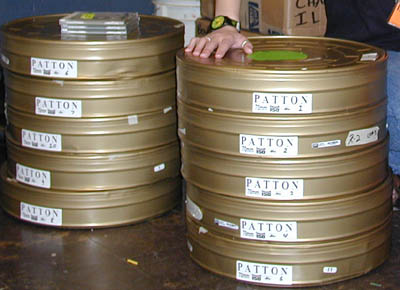|
|
This topic comprises 2 pages: 1 2
|
|
Author
|
Topic: Cans with shafts to hold the cores steady
|
|
|
Leo Enticknap
Film God

Posts: 7474
From: Loma Linda, CA
Registered: Jul 2000
|
 posted 10-18-2002 10:05 AM
posted 10-18-2002 10:05 AM





Do you mean the quite thick orange ones that have weird flanges on the side which can make the cans a tad difficult to open?If so the French national film archive, the Cinémathèque Française, has been using them to ship their viewing copies for years. I agree - the centre spindle is an excellent idea for keeping the reel in place. I'd love to know where you can get them. These are the cans we usually get at present: vented for prevention of VS but they don't have any centre spindle. It's a pity that France's own commercial distributors can't follow their archive's lead: they still seem to re-use the thin sheet-metal aluminium cans in which raw stock is supplied to the lab. Needless to say, these get eaten alive in most shipping boxes, especially the 'green goddess' ones in which the slot was about half an inch shorter than the diameter of a 2,000 foot can, thus crushing the side of one when inserted using brute force.
| IP: Logged
|
|
|
|
|
|
|
|
John Pytlak
Film God

Posts: 9987
From: Rochester, NY 14650-1922
Registered: Jan 2000
|
 posted 10-18-2002 01:07 PM
posted 10-18-2002 01:07 PM





Leo wrote: "...they still seem to re-use the thin sheet-metal aluminium cans in which raw stock is supplied to the lab. Needless to say, these get eaten alive in most shipping boxes..."  The gray or gold coated STEEL cans Kodak uses for raw stock are quite sturdy and durable, and are reused for processed film by most customers. Kodak packages large rolls of print film raw stock in thick vacuum-seal bags, that maintain excellent roll integrity and protection. ------------------
John P. Pytlak, Senior Technical Specialist
Worldwide Technical Services, Entertainment Imaging
Research Labs, Building 69, Room 7525A
Rochester, New York, 14650-1922 USA
Tel: +1 585 477 5325 Cell: +1 585 781 4036 Fax: +1 585 722 7243
e-mail: john.pytlak@kodak.com
Web site: http://www.kodak.com/go/motion
| IP: Logged
|
|
|
|
|
|
Steve Kraus
Film God

Posts: 4094
From: Chicago, IL, USA
Registered: May 2000
|
 posted 10-18-2002 04:51 PM
posted 10-18-2002 04:51 PM



There are or were two different kinds of stock cans. The gray or gold Kodak can is indeed very sturdy. The kind which is described as flimsy is shiny and silvery in color and made of very thin metal. Perhaps these are from other manufacturers?The central hub does sound like a great idea. Of course best of all are the 70mm tins. Not because they are constructed differently but because of what awaits inside.  
| IP: Logged
|
|
|
|
Leo Enticknap
Film God

Posts: 7474
From: Loma Linda, CA
Registered: Jul 2000
|
 posted 10-19-2002 06:15 AM
posted 10-19-2002 06:15 AM





I've never seen a 70mm tin! All the 70mm prints I've ever handled came in sodding great transit cases - one per reel - with the reel itself mounted on a running spool. Most of the running spools were badly thrown together with lethally sharp edges, and I'd always run the prints from a set of house spools.Showing 70mm this way was a great personal fitness regime! An afterthought on the above: steel or aluminium containers are obviously no problem for pre-print material, because it is never likely to be transported long distances and the element will spend 99% of its lifetime sitting on a shelf. But if an element (i.e. most release prints of mainstream titles) is going to be regularly subjected to Securicor abuse over a relatively short working life, then IMHO inert, reinforced polypropylene is the way to go. For proof of this, look at the top left container in Steve's picture. Immediately below the bottom right corner of the three DTS disc cases you'll see a dent in the side of the can. After a few crossovers the metal 2,000 foot 35mm cans would be so deformed by dents like these that they'd be completely unusable - you certainly wouldn't have a hope in hell of forming an airtight seal.
| IP: Logged
|
|
Steve Kraus
Film God

Posts: 4094
From: Chicago, IL, USA
Registered: May 2000
|
 posted 10-19-2002 11:20 AM
posted 10-19-2002 11:20 AM



Of course the labels on the tins are ones I made. You can barely make out 70mm; between that and the reel number are D150 and DTS logos. I presume that print was eventually put in reels and cases. In the meantime I found some bubble wrap and put several wads in each can to protect the rolls when I returned the print. The only handling problem (with a very gentle Kinotone platter*) was that many of the cores had distorted inner diameters and would not fit the flange hub of the MUT but the core adaptor comes off and building up the shaft with a couple of narrow strips of gaffer tape enabled smooth handling. I would have replaced the cores if I'd had a supply (even 35mm doubled up) but I did not. Not sure why the core middles were damaged but it didn't seem like it was from rough shipping. (This was at Ebertfest last April and a search will no doubt turn up discussion of the print and DTS etc.) * Plattering just the 70mm & a silent, otherwise C/O with two Norelco AA-II's. BTW, back to the topic, I found one of the shiny silvery thin metal cans and it was indeed from Kodak but it's probably 10+ years old. Not too often nowadays that something gets thicker, heavier, and generally better. Thank you, Kodak.
| IP: Logged
|
|
John Pytlak
Film God

Posts: 9987
From: Rochester, NY 14650-1922
Registered: Jan 2000
|
 posted 10-19-2002 01:17 PM
posted 10-19-2002 01:17 PM





Steve Kraus wrote: "BTW, back to the topic, I found one of the shiny silvery thin metal cans and it was indeed from Kodak but it's probably 10+ years old. Not too often nowadays that something gets thicker, heavier, and generally better. Thank you, Kodak."You're welcome!  The change was made quite a few years ago, when it was recognized that if a can rusted, it could contribute to vinegar syndrome. The new cans are stronger, and coated with an inert rust-proof coating. The gold ones are specific to the Kodak VISION line of film products. The change was made quite a few years ago, when it was recognized that if a can rusted, it could contribute to vinegar syndrome. The new cans are stronger, and coated with an inert rust-proof coating. The gold ones are specific to the Kodak VISION line of film products. For raw stock, metal is preferred to plastic, for its superior properties as a moisture and vapor barrier, especially with cold storage. ------------------
John P. Pytlak, Senior Technical Specialist
Worldwide Technical Services, Entertainment Imaging
Research Labs, Building 69, Room 7525A
Rochester, New York, 14650-1922 USA
Tel: +1 585 477 5325 Cell: +1 585 781 4036 Fax: +1 585 722 7243
e-mail: john.pytlak@kodak.com
Web site: http://www.kodak.com/go/motion
| IP: Logged
|
|
|
|
|
|
|
|
All times are Central (GMT -6:00)
|
This topic comprises 2 pages: 1 2
|
Powered by Infopop Corporation
UBB.classicTM
6.3.1.2
The Film-Tech Forums are designed for various members related to the cinema industry to express their opinions, viewpoints and testimonials on various products, services and events based upon speculation, personal knowledge and factual information through use, therefore all views represented here allow no liability upon the publishers of this web site and the owners of said views assume no liability for any ill will resulting from these postings. The posts made here are for educational as well as entertainment purposes and as such anyone viewing this portion of the website must accept these views as statements of the author of that opinion
and agrees to release the authors from any and all liability.
|

 Home
Home
 Products
Products
 Store
Store
 Forum
Forum
 Warehouse
Warehouse
 Contact Us
Contact Us




 Printer-friendly view of this topic
Printer-friendly view of this topic





 .
.














